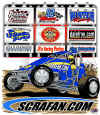


|
Traditional Sprint Car FanSite |
See You At The Races!!! |
| Technology
- New & Old by Norm Bogan |
|
|
|
As I recently viewed a race on television, I was amazed at the quality of the on-board camera pictures. I thought back to a few years ago, when very little auto racing was televised and most was taped for later viewing. There were no on-board cameras; in fact they only used about three cameras to shoot the whole race, including a portable in the pits. We often refer to the technology explosion in racing and much of this has been incorporated into the coverage of the races. To look back, I’ll draw on my own experiences while serving on a Winston Cup crew in the early seventies. First off, we now are privy to conversations between the drivers and their crew chiefs, plus we can eavesdrop on their spotters instructions on when to go on a restart or trouble ahead on the track. In my era, a spotter stood on a stack of tires in the pits and commented; “he hasn’t come around yet”. Communication between the driver and the pits was done through use of a black board along the front straightaway wall and numerous hand signals. On the board, we would note “P-2L” meaning pit in two laps, “72 +7” meaning car #72 is seven seconds ahead of you, or something a little easier to decipher like “tires-OK”, which meant that tires changed on a pit stop showed no unusual tire wear. The
driver’s hand signals were usually; 1 for tires, 2 for fuel, 3 for hot and 4
for oil. Sometimes, they would do a
thumbs-up to take weight out of the car and thumbs-down to tighten it up.
The driver patting himself on the head was the indication that he needed
a relief driver. There were other
predetermined signals between driver and crew, often camouflaged from the
competition. Strategies were
usually worked out prior to the race and then the crew chief made the necessary
adjustments during the race. Today,
the crew chief can have an ongoing conversation with his driver.
The driver gets information by radio on his position, status of the
racecar, what cars may be challenging, plus condition of tires and other changes
made during pit stops. The spotter
usually perched atop the press box, can prepare the driver for the impending
race restart or warn of adverse conditions on the track. From his vantage point,
the spotter can view the outside of the car, unseen from the pits, for a tire
rubbing after an altercation or a possible fluid leak. In
some forms of racing, telemetry is allowed and the pits have computer monitors
recording everything from tire temperatures to rpms at each gear shift, to
numerous engine performance points. Various
airfoil settings and their performance are also noted.
Fuel mileage may also be calculated.
Formula One and Champ cars have a mini-dash with digital readout, that
indicates pertinent information to the driver. For
the racers that cannot use telemetry, the driver has three basic gauges; water
temperature, oil pressure and engine speed (tachometer).
The tachometer has new significance now that some racing bodies have pit
road speed limits. A driver must
know for example, that 5800 rpm in second gear is equal to 55 mph and monitor
the tach to prevent penalties. |
